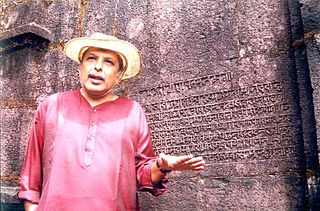
Shivaji I was an Indian ruler and a member of the Bhonsle dynasty. Shivaji carved out his own independent kingdom from the Sultanate of Bijapur that formed the genesis of the Maratha Confederacy.

Sambhaji, also known as Shambhuraje, was the second Chhatrapati of the Maratha Empire, ruling from 1681 to 1689. He was the eldest son of Shivaji, the founder of the Maratha Kingdom. Sambhaji's rule was largely shaped by the ongoing wars between the Marathas and the Mughal Empire, as well as other neighbouring powers such as the Abyssinians of Janjira, Wadiyars of Mysore and the Portuguese Empire in Goa. After Sambhaji's execution by Aurangzeb, his brother Rajaram I succeeded him as the next Chhatrapati and continued the Mughal–Maratha Wars.

The Peshwa was the second highest office in the Maratha Confederacy, next in rank and prestige only to that of the Chhatrapati. Initially serving as the appointed prime minister in the Maratha Kingdom, the office became hereditary after the death of Shahu in 1749. During the reign of Shahu, the office of Peshwa grew in power and the Peshwas came to be the de facto rulers of the Maratha Confederacy. However following the defeat of the Marathas in 1761, the office of the Peshwa became titular as well and from that point onwards served as the ceremonial head of the Confederacy underneath the Chhatrapati.
Firangoji Narsala was a Maratha warrior and military leader in the army of Shivaji Maharaj, in 17th century India. He is famous for his defence of Sangram Durg, a fort, against a Mughal army led by Shaista Khan in 1660.

Chhatrapati is a royal title from Sanskrit used to denote a king. The word "Chhatrapati" is a Sanskrit language compound word of chhatra and pati (master/lord/ruler). This title was used by the House of Bhonsle, between 1674 and 1818, as the heads of state of the Maratha Confederacy.
The Bhonsle are a prominent group within the Maratha clan system.
Moropant Trimbak Pingale, was the first peshwa of the Maratha Empire, serving on Shivaji Maharaj's Ashta Pradhan.

Gingee Fort or Senji Fort in Tamil Nadu, India is one of the surviving forts in Tamil Nadu, India.It is popularly known as Great Wall of South India.It lies in Villupuram District, 160 kilometres (99 mi) from the state capital, Chennai, and is close to the Union Territory of Puducherry. The site is so fortified that Chhatrapati Shivaji Maharaj, the Maratha king, ranked it as the "most impregnable fortress in India", and it was called the "Troy of the East" by the British. The nearest town with a railway station is Tindivanam and the nearest airport is Chennai (Madras), located 150 kilometres (93 mi) away.

Maharani Tarabai Bhosale (née Mohite) was the regent of the Maratha Empire from 1700 until 1708. She was the queen of Rajaram I, and daughter-in-law of the kingdom's founder Shivaji I. She is acclaimed for her role in keeping alive the resistance against Mughal rule in Konkan, and acting as the regent of the Maratha Empire during the minority of her son, Shivaji II. She defeated Mughal forces of Aurangzeb in several battles and expanded the Maratha Empire.

Sangram Durga is a land fort situated at Chakan, Pune, Maharashtra, India. The original area of the fort was 65 acres, currently it is only 5.5 acres.

The battle of Surat, also known as the Sack of Surat, was a land battle that took place on 5 January 1664, near the city of Surat, in present-day Gujarat, India, between Shivaji, leader of the fledgling Maratha State and Inayat Khan, a Mughal commander. The Marathas defeated the Mughal military unit posted at Surat.
Soyarabai Bhosale née Mohite was second wife of Shivaji Maharaj, the founder of Maratha empire in western India. She was mother of Shivaji Maharaj's second son, Rajaram. She was the younger sister of Maratha army chief Hambirrao Mohite.

Saibai Bhosale was the wife consort of Chattrapati Shivaji, the founder of the Maratha Empire. She was the mother of her husband's successor Chattrapati Sambhaji.

Ramchandra Neelkanth Bawadekar (1650–1716), also known as Ramchandra Pant Amatya, served on the Council of 8 as the Finance Minister (Amatya) to Emperor (Chhatrapati) Shivaji, dating from 1674 to 1680. He then served as the Imperial Regent to four later emperors, namely Sambhaji, Rajaram, Shivaji II and Sambhaji II. He authored the Adnyapatra, a famous code of civil and military administration, and is renowned as one of the greatest civil administrators, political thinkers, diplomats and military strategists of the Maratha Empire.

Vijaydurg, the oldest fort on the Sindhudurg coast, was constructed during the regime of Raja Bhoja II of the Shilahar dynasty and restructured by Shivaji.

Prabalgad is a fort located between Matheran and Panvel and comes under the Raigad District in the state of Maharashtra, India.

The Kolhapur State was a Maratha princely state of India, under the Deccan Division of the Bombay Presidency, and later the Deccan States Agency. It was considered the most important of the Maratha principalities with the others being Baroda State, Gwalior State and Indore State. Its rulers, of the Bhonsle dynasty, were entitled to a 19-gun salute – thus Kolhapur was also known as a 19-gun state. The state flag was a swallow-tailed saffron pennant.

Ninad Gangadhar Bedekar was a historian, writer and orator from Pune, Maharashtra, India, writing and speaking in Marathi. He was specialized in research of the rule of warrior-king Chatrapati Shivaji Maharaj.

The Battle of Purandar was fought between the Mughal Empire and the Marathas in 1665.
The Battle of Salher was fought between the Marathas and the Mughal Empire in February 1672 CE. The battle was fought near the fort of Salher in modern-day Nashik district. The result was a decisive victory for the Marathas. This battle is considered particularly significant as it is the first pitched battle where the Mughal Empire lost to the Marathas.














